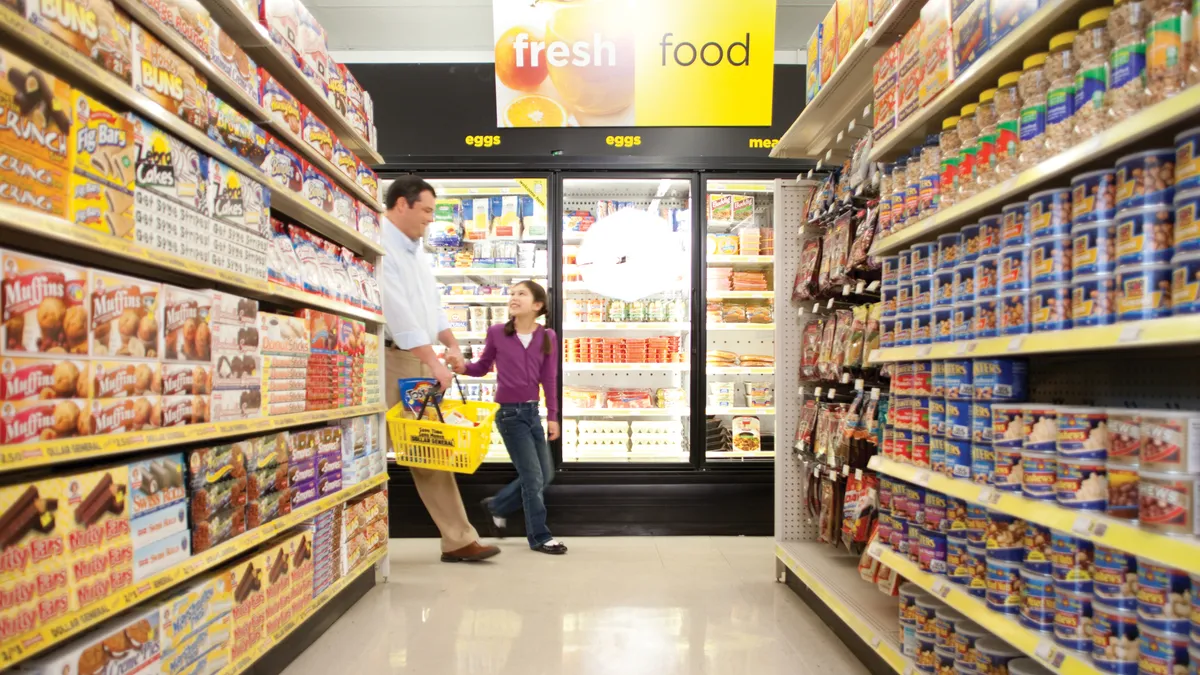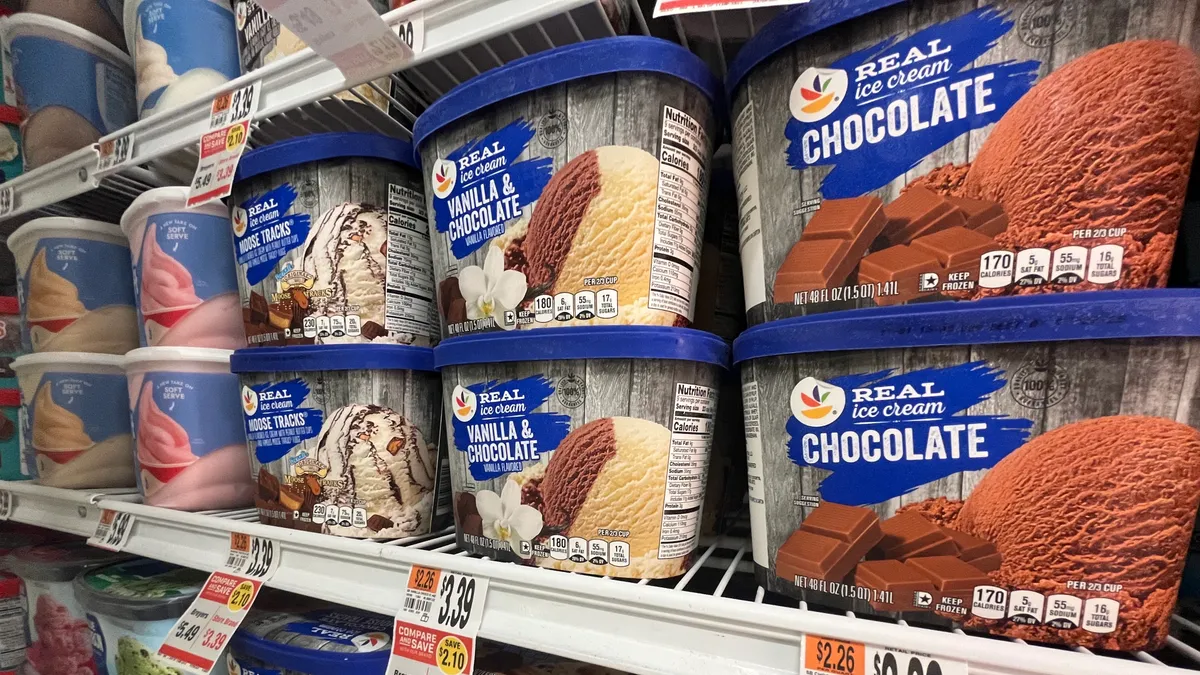Not so long ago, dollar stores were the oddballs of the retail world, home to an assortment of discontinued groceries, party supplies, inexpensive toys and other low-priority goods. They were so non-threatening to traditional retailers that some, like Wal-Mart, co-located with them.
What a difference a few years and an economic downturn makes. Beginning with the recession in 2008, value-focused consumers began turning their attention to the dollar stores in their communities. Companies like Dollar General and Family Dollar capitalized by tightening up their operations and increasing their assortment of groceries, household goods and other consumables.
Not only did dollar stores manage to seize the moment — they retained many of these customers for the long run and continued to make gains. According to research firm GlobalData Retail, sales at dollar stores grew from $30 billion to $45 billion between 2010 and 2015, a 50% growth clip that far outpaced the 17% growth seen by retail overall.
But can dollar stores dollar stores keep this growth going?
An updated — and desired — store format
“Twenty-five years ago, you saw dollar stores inside strip malls and supermarkets because they generated some decent traffic,” Richard George, professor emeritus of food marketing at St. Joseph University’s Haub School of Business, told Food Dive. “In the last 10 years, their amount of consumables has increased to the point that they’re a major competitor.”
With three-quarters of their stock dedicated to everyday necessities like toilet paper, cereal and cleaning supplies, dollar stores have long catered to regular fill-in trips. During the past few years, analysts say, dollar stores have strengthened their mix of consumables through improved merchandising and by stocking more in-demand branded products.
Dollar stores also caught on to what other retail formats long ago realized: Food drives traffic. Customers visiting a dollar store today can grab frozen meals, prepared sandwiches and salads, and even fruits and vegetables. On its website, 99 Cents Only advertises daily deliveries of “farm fresh produce.”
Ken Morris, principal at consulting firm Boston Retail Partners, said customers aren't the only ones taking dollar stores more seriously. Manufacturers are, too.
“CPG manufacturers are paying more attention to dollar stores, and are offering dollar-sized packaging and more brand-name merchandise beyond the traditional secondary brands and discontinued products they sold in the past,” he told Food Dive.
At the same time, dollar stores have retained what numerous sources called their “treasure hunt” appeal by offering a limited assortment of home décor, clothing, and various knickknacks.
Dollar stores have a product mix that appeals to the core demographic of low- and middle-income consumers. What’s surprising many in the industry — including dollar stores themselves — is that it appeals to millennials and high-income shoppers, too. According to checkout data gathered by the NPD Group, 25% of customers at the three biggest dollar chains are millennials from households earning $100,000 or more.
This makes perfect sense to Morris, who says millennials adjust their spending by category.
“Many affluent millennials are choosing to save money on consumable products and splurging on experiences and big-ticket items,” he said.
The data doesn’t surprise George, either. He’s studied millennial shopping habits for several years, and said they’re very receptive to buying through alternative channels.
“If you talk to millennials, you learn that many of them haven’t stepped foot in a traditional supermarket for a very long time,” George told Food Dive.
Dollar stores’ growth across income levels has taken a toll on traditional retailers by pressuring their prices and by chipping away at margins. Some supermarkets, in response, have cribbed directly from the dollar store playbook, offering more dollar items and deals like ten items for $10. Many stores like Target now have a special section stocked with $1 products.
Fending off the Wal-Marts
No retailer knows the pressures of dollar stores better than Wal-Mart, which serves many of the budget-conscious shoppers that Dollar General, Family Dollar and company have targeted.
“What dollar stores did is reverse the formula on Wal-Mart,” Neil Stern, senior partner with retail consulting firm McMillanDoolittle told Food Dive. “Wal-Mart made a lot of money by putting up a supercenter in one community and then drawing from three or four communities. Dollar stores came in and said, ‘We’re going to put five of our stores in between the customer and their journey to Wal-Mart.’ ”
The world’s largest retailer fought back with its own dollar-store offshoot called Wal-Mart Express. But the format failed to catch on, and shuttered last year. The company sold its 102 stores to Dollar General.
If dollar operators can fend off Wal-Mart, sources say, they can survive pretty much anything. Indeed, dollar stores are immune to many of the headwinds that can slow down other retailers. They thrive in a weaker economy; they’re small, which means they have low overhead and are easy to build and tear down; and the stores don’t require much investment. The growth formula for dollar companies, Stern said, is to build a lot of small stores that generate around $1.5 million in sales each year, and let the numbers add up. This year, Dollar General plans to open 1,000 stores, or roughly three a day.
Some wonder, though, if that breakneck pace will eventually catch up with dollar store operators. Neil Saunders, managing director of GlobalData retail, said that while their small footprint means they have “loads of head room to grow across the U.S.,” some stores have hit a saturation point in certain markets.
“In some areas stores are cannibalizing each other’s sales,” he told Food Dive.
Dollar stores are also sensitive to economic pressures. Minimum wage increases could have an impact, according to Stern. And just as the recession turned many on to the dollar format, so could a flush economy give pricier competitors the chance to lure them away.
A new administration gives these issues added relevance.
“If the economy improves we may see the wind come out of their sales a bit,” said Stern.
New opportunities for growth
Dollar retailers aren’t waiting to see which way the wind blows. In addition to its ambitious store growth plans, Dollar General is also experimenting with new formats and growing its private label selection. Last month, the company opened DGX, a store concept aimed at urban millennials, in Nashville.
Meanwhile, Dollar Tree, which acquired Family Dollar in a $9.1 billion deal in 2014, is beginning to realize operational efficiencies from its joint venture. The number of stores under the newly formed company now number close to 14,000.
Continuing at the same frenzied pace they’ve enjoyed in recent years will be challenging, sources say. Most likely, sales will grow at a more modest clip that reflects the market’s maturity, consumer preferences and the various adjustments that competing retailers are making.
“I don’t see their growth being as exponential as it’s been in the past, but I don’t think it’s going away,” said George. “I think you’re seeing evolution with the urban format, and I think you’re going to see more and more evolution in food and consumables.”
One growth avenue George sees for dollar companies is targeting convenience stores, which offer similar goods and the same sort of fill-in shopping trips.
“They’ve got c-store products at dollar store prices, and they’re in the same places as c-stores,” he said.
Likewise, Saunders said growth becomes more and more difficult the larger dollar companies become. This may, he said, necessitate a change in their usual tactics, like focusing resources on existing stores in addition to opening new ones.
“We’re likely to see a bigger focus on making existing stores work harder and looking at how to increase basket sizes and customer conversions in those stores,” he said. “That said, the pace of new store growth will still be extensive, especially compared to other sectors of retail.”























